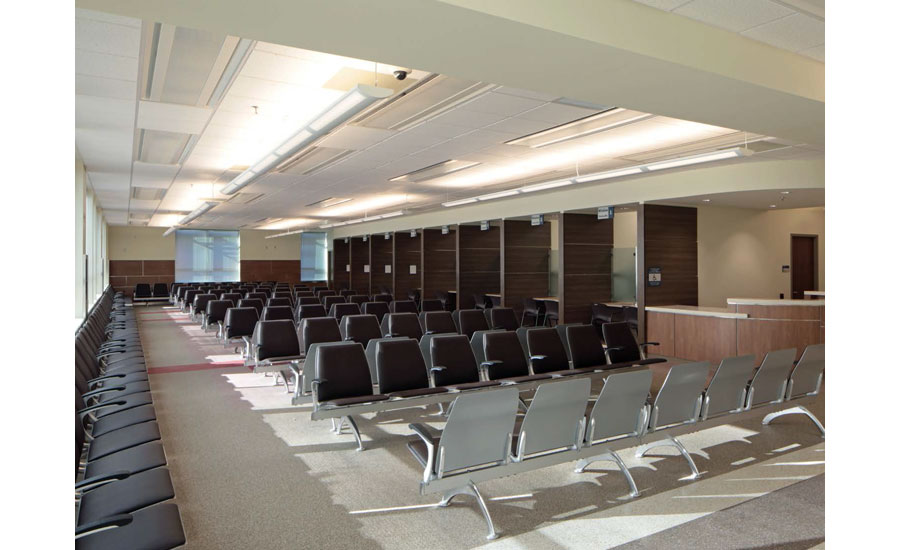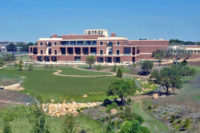The heart of the facility’s sustainability is its HVAC system featuring active chilled beams, dedicated outdoor air systems (DOAS), and high-efficiency boilers and chillers. According to energy modeling, the combination of technology results in more than a 62-percent energy savings versus conventional building HVAC methods. Daily energy tracking reveals the building ranks in the upper 22-percentile of Energy Star Program facilities nationwide. Energy modeling has demonstrated the building also surpasses requirements of the ASHRAE Standard 90.1 (2004) Energy Standard for Buildings, except Low-Rise Residential Buildings by 44 percent.
The result is energy savings and environmental stewardship that attracts green-minded tenants and buyers. Furthermore, occupants feel a noticeable air comfort difference mainly due to tightly controlled temperature tolerances and relative humidity (RH) levels that chilled beams and DOAS offer. Other sustainable features adding to the well-being of occupants are day lighting, LED lighting, water conserving plumbing fixtures, and an accessible vegetated rooftop gathering area irrigated by recaptured rainwater. “Many of our tenants say they’ve never felt this type of air comfort or atmosphere in an office building,” said Scott Mazo, principal, University Partnership Associates (UPA), Philadelphia, which developed the property as Philadelphia’s first multiple-certified Leadership in Energy and Environmental Design (LEED®) Platinum buildings and one of few nationwide.
LEED Platinum doesn’t stop with just the facility, however. Three tenants have already achieved and four more tenants are pursuing LEED Platinum certification under the “Commercial Interiors Rating System,” which will make 2.0 University Place the world’s first multi-tenant, multi-certified LEED Platinum building.
Real estate investors have also taken notice. UPA sold the five-story property to Swiss-based Zurich Insurance Group (ZIG) in April 2016. “As a buyer, they recognized not just the energy efficiency and technology features, but also the commitment to sustainability, which is important to them,” said Mazo.
CHILLED BEAMS’ CONTRIBUTION TO LEED AND IAQ
The bulk of the HVAC system’s LEED credits and air comfort were achieved with 500 active chilled beams and their induction principle operation. Air around ceiling-mounted chilled beam water coils continually cools and falls while warmer air rises in a continual convection of air comfort benefits with no drafts, no noise, and stable temperature tolerances of ±1°F. Chilled beams also reduce fan energy by up to 50 percent versus the large fan horsepower required in the conventional rooftop DX, ductwork, and variable air volume (VAV) system the design team considered. “The chilled beam system is a major contributor to the building’s sustainability story and ongoing energy efficiency,” said Michael W. Pavelsky, sustainability director, LEED AP at The Sheward Partnership, which tracks and records the facility’s energy performance.
Supplying the chilled beams is a four-pipe system for heating and cooling consisting of pre-insulated polypropylene (PP-R) pipe by Aquatherm, Lindon, Utah, that’s used in pressurized plumbing and HVAC applications. Aquatherm’s highly-efficient piping helped accumulate LEED HVAC credits as well as other pipe loop components, such as a 98 percent efficient 2,000-MBH condensing boiler manufactured by Lochinvar, Lebanon, Tennessee; a 200-ton air-cooled chiller manufactured by Daikin Applied, Minneapolis; and four 25 hp pumps by Bell & Gossett, Morton Grove, Illinois. The four-pipe system allows simultaneous heating and cooling options during fall and spring seasonal changes, and it helps offset perimeter heat loss and solar gain.
The building’s envelope is very efficient with R-42 opaque wall assembly, R-30 roof assembly, and southern exterior sun shades manufactured by Tubelite, Walker, Michigan, according to Chloe Bendistis, LEED AP, The Sheward Partnership’s sustainability project manager.
While some chilled beam brands use factory-set airflow nozzles that require replacement or complicated pressure balance calibrations for cfm rate changes, the IQHC model features a proprietary 12-slot nozzle that’s field-adjustable with two easily-accessed hand-operated levers for providing a unilateral, disproportional, or equal air volume from each side. Accord Mechanical and its testing and air balancing (TAB) contractor, Independent Balancing Co., Philadelphia, both received factory-assisted chilled beam training. “The chilled beams in the external zones definitely needed different nozzle adjustments than internal zones,” said Ulrick Joseph, principal, Mark Ulrick Engineers, which specializes in mechanical, electrical, plumbing, and fire/ safety building systems.
OUTDOOR AIR REQUIREMENTS
Outdoor air requirements and condensation prevention is achieved with one 20,000 cfm rooftop PVS-24 Pinnacle DOAS unit manufactured by Semco. The Pinnacle uses its own DX condenser so that the chiller is dedicated to just the chilled beams. The Pinnacle controls its operation independent of the building automation system (BAS) by Delta Controls Inc., Surrey, British Columbia. Each active chilled beam’s six-inch-diameter outdoor air takeoff is supplied with conditioned outdoor air to avoid condensation from the chilled water loop’s 48°F discharge. Ventilation air depends on the chilled beam’s size and ranges from 25-85 cfm, which satisfies the building’s outdoor air requirements and surpasses ASHRAE 62.1 standards for commercial buildings, according to Joseph.
“Most chilled beam manufacturers don’t make DOAS units,” said Mazo. “A manufacturer making both the active chilled beams and the outdoor air unit to supply them dehumidified air was integral for synergy and purposes of single source responsibility.”MECHANICAL CONTRACTOR RACKS UP LEED CREDITS
Accord Mechanical also helped rack up LEED credits with its sheet metal fabrication and jobsite environmental compliances:
- Ductwork fabricated at its Norristown sheet metal shop was wrapped in plastic prior to shipping, which kept it cleaner for IAQ reasons, and eliminated environmentally-damaging chemicals to clean it onsite;
- Ductwork trunks lines were wrapped with an environmentally-friendly R-20 insulation, manufactured by Johns-Manville, Denver, Colorado.
- Pre-insulated flexible six-inch-diameter take-offs supply air to the chilled beams; and
- Firestop materials for sealing floor and wall pipe/duct penetrations were environmentally friendly.
2.0 University Place’s quick sale to ZIG helps facilitate UPA’s next sustainable project in the University City District on an adjacent lot, 3.0 University Place.
3.0 University Place is the forefront of green building design in Philadelphia. The 189,000-square-foot, Class A structure will be completely eco-friendly, earning a Platinum Certification rating from the U.S. Green Building Council’s LEED program — the highest standard for environmentally sustainable construction. It was the first Platinum Pre-certified global pilot 6 project for LEED v4. Again, Mazo plans to anchor the HVAC system with chilled beams and Pinnacle DOAS, with the addition of Neuton, a smart, plug-and-play controlled chilled beam pump module, which promises to cut the chilled beam system’s piping installation/material costs by 50 percent. Manufactured by Semco, Neuton will reduce chilled beam piping by half because they decentralize temperature/humidity control by zones of 10 chilled beams or less.
While some real estate industry members perceive LEED buildings as exorbitant in cost, Mazo said the indoor air comfort, energy efficiency, and commitment to saving the environment far outweighs the additional cost. “The ROI [return on investment] on the additional cost of making this building LEED Platinum is 100 percent in terms of the rental premium, energy efficiency, operating efficiency, and the purchase premium.”
Publication date: 4/3/2017
Want more HVAC industry news and information? Join The NEWS on Facebook, Twitter, and LinkedIn today!









